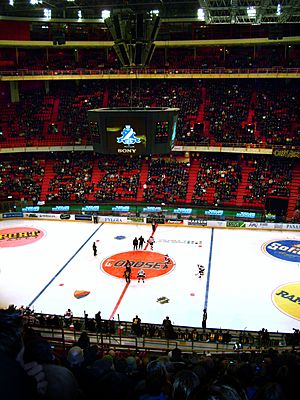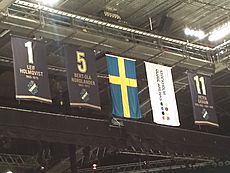AIK IF facts for kids
Quick facts for kids AIK |
|
|---|---|
| City | Stockholm, Sweden |
| League | HockeyAllsvenskan |
| Founded | 1921 (1891) |
| Home arena | Hovet and Avicii Arena |
| Colors | |
| General manager | Niklas Persson |
| Head coach | Markus Åkerblom |
| Captain | Filip Windlert |
| Website | aikhockey.se |
| Franchise history | |
| 1921–1923, 1925–present | AIK |
| Championships | |
| Le Mat Trophy | 1934, 1935, 1938, 1946, 1947, 1982, 1984 |
AIK Hockey is the ice hockey team of the famous sports club AIK in Stockholm, Sweden. The team is officially called Allmänna Idrottsklubben Ishockeyförening (AIK IF). Since 2014, AIK's men's team has played in HockeyAllsvenskan, which is the second-highest league for ice hockey in Sweden. Before that, they spent four years in the top league, the SHL. The women's team plays in the Swedish Women's Hockey League, which is the top league for women's ice hockey.
AIK plays most of its home games at Hovet, an arena that can hold 8,094 fans. For bigger games, they sometimes play at Avicii Arena, which is much larger and can hold 13,850 people.
AIK has a long history in Swedish ice hockey. They have played 66 seasons in Sweden's top division, with 27 of those in the SHL. They have won the Le Mat Trophy seven times, becoming Swedish champions in 1934, 1935, 1938, 1946, 1947, 1982, and 1984. They have also finished as runner-up six times.
Contents
History of AIK Hockey
The Early Years (1921–1977)
AIK's ice hockey team started in 1921, thanks to Anton Johansson. Their very first competition was a series called Träningsserien, which they won! However, the team closed down just two years later in 1923. Luckily, it was started up again in 1925.
AIK joined the top league, then called Elitserien, in the 1930–31 season. They finished fifth and made it to the playoffs, but lost in the semifinal. The next season, AIK finished first in the league but again lost in the semifinal.
In 1934, AIK won their first championship! They beat their big rival, Djurgårdens IF, on their way to the final. In the final game, AIK played against Hammarby IF and won 1–0.
AIK and Hammarby met many times in championship games. AIK won the trophy again in 1935, beating Hammarby 2–1. In 1936, Hammarby got their revenge, beating AIK in the final. AIK won their third championship in 1938, again defeating Hammarby 2–0. In 1940, AIK lost the final to IK Göta. It took four years for AIK to reach the final again in 1945, but they lost to Södertälje. However, AIK won the championship in both 1946 and 1947.
After these successful years, AIK often moved between the top league (then called Division I) and the second league (Division II) from 1954 to 1960. In 1960, AIK returned to the highest division. It would be almost two decades before they reached another final. Their best result during this time was reaching the quarterfinal in the 1965–66 season.
The Golden Era (1978–1984)
In 1978, AIK had an exciting semifinal series against Brynäs IF. After losing the first game, AIK won the second game at Hovet with a huge 8–0 score. This forced a third game, which AIK won 3–2. They reached the final but lost to Skellefteå AIK.
After two tough seasons, AIK's "golden era" began. In the 1980–81 season, they finished second in the league and made the playoffs. They easily beat Västra Frölunda IF in the semifinals. In the final, they faced Färjestads BK and became the second-best team again.
The next season, AIK finished third. They met Färjestad again in the semifinals and won both games to reach the final. Their opponent was IF Björklöven. AIK lost the first game but won the next two. They had a chance to win the championship at Hovet, but Björklöven won that game. The deciding fifth game was played in Gothenburg, where AIK won 3–2. This made them Swedish champions for the first time in over 30 years! The next season, Färjestad got their revenge by knocking AIK out in the semifinals.
But AIK didn't have to wait long to celebrate again. In the 1983–84 Elitserien season, AIK finished first in the league. In the semifinals, they beat Södertälje. In the best-of-three finals, AIK faced their rivals, Djurgården. This was the first and only time these two Stockholm teams met in a Swedish Championship final. AIK won the first game 5–2 and the second 2–0. The final game ended 4–1 for AIK, making them 1984 Swedish Champions. This was their seventh title, and their most recent one.
Ups and Downs (1985–2006)
After their big win in 1984, AIK had a tough time. They didn't make the playoffs the next season and were even sent down to Division 1 in 1986. But they quickly bounced back, winning their Division 1 group perfectly and getting promoted back to Elitserien.
In 1988, AIK won against Djurgården in the quarterfinals but lost to Färjestad in the semifinals.
In the 1992–93 season, AIK finished last and were sent down to Allsvenskan. They lost a playoff series to Hammarby and were relegated to Division 1.
AIK didn't stay in Division 1 for long. They won their division and made it to the playoffs. In a memorable game, AIK needed to beat Bodens IK by three goals to get promoted back to Elitserien. They won 3–0, and their goalie Rolf Ridderwall made a crucial save in the final minutes, sending AIK back to the top league!
AIK didn't reach the playoffs in 1994–95 or 1995–96. However, the next season, they made it to the semifinals after beating Djurgården. But Luleå HF won the series against them.
In 1998, AIK had to play in a special qualification series to stay in Elitserien, which they successfully did. For the next two seasons, AIK missed the playoffs.
In the 2000–01 season, AIK played their last playoff series in Elitserien for a while, losing to Djurgården. The next season, they finished eleventh and were relegated to Allsvenskan.
AIK spent the rest of the decade in lower leagues. They made it to the qualification series for Elitserien twice but couldn't get back in. In 2004, AIK was even relegated to the third-tier league, Division 1, because of money problems. The next season, they finished first in their division. Thanks to the 2004–05 NHL lockout, NHL players like Mattias Norström and Georges Laraque joined AIK, helping them get promoted back to Allsvenskan.
Return to Elitserien (2010)
AIK made a big effort to return to Elitserien in the 2008–09 season. They hired Roger Melin, a former coach for the Swedish national team, and brought in experienced players.
In the 2009–10 season, AIK finished second in HockeyAllsvenskan and qualified for the Kvalserien (a promotion series), but just missed out on promotion. The next season, they finished second again and made it to the Kvalserien once more. With only one game left, AIK was in the second and final promotion spot. They won their last game 2–0 and returned to the top league, Elitserien, after eight years!
AIK's first season back in Elitserien (2010–11) was a huge success. Many experts thought they would struggle, but the team made it to the playoffs. Their goalie, Viktor Fasth, played incredibly well and won the Honken Trophy award. In the quarterfinals, AIK surprised everyone by beating the regular season champions, HV71, 4–0. In the semifinals, they faced Färjestads BK and were knocked out.
In the 2011–12 season, AIK did even better, finishing seventh and making the playoffs again. Richard Gynge scored 28 goals and won the Håkan Loob Trophy, and Robert Rosén led the league in points. Viktor Fasth won the Honken Trophy for the second year in a row. AIK beat the regular-season champions, Luleå HF, in the quarterfinals. They reached the semifinals for the second year in a row but were eliminated by Skellefteå AIK in a close seven-game series.
After the 2011–12 season, coach Roger Melin left the club. Per-Erik Johnsson became the new head coach.
KHL Invitation (2009)
In November 2009, AIK was invited to join the Kontinental Hockey League (KHL), a major league in Europe and Asia. The plan was for AIK to join in the 2010–11 season. AIK held a meeting with its fans to vote on the idea. However, the Swedish Ice Hockey Association did not allow AIK to join the KHL.
Team Captains
AIK has had many great leaders over the years. Here are some of the players who have served as team captain:
- Rikard Franzén, 2000–01
- Anders Gozzi, 2002–03
- Roger Rosén, 2003–04
- David Engblom, 2004–08
- Dick Tärnström, 2008–13
- Patric Blomdahl, 2013–15
- Christian Sandberg, 2015–2019
- Jacob Dahlström, 2019–2020
- Filip Windlert, 2020–2021
- Christian Sandberg, 2021–present
Honored Members
Some players have been so important to AIK that their jersey numbers have been retired. This means no other player on the team will ever wear that number again. It's a special way to honor their contributions.
| No. | Player | Position | Career | No. retirement |
|---|---|---|---|---|
| 1 | Leif Holmqvist | G | 1964–1975 | – |
| 2 | Mats Thelin | D | 1980–1984, 1987–1994 | – |
| 5 | Bert-Ola Nordlander | D | 1963–1973 | – |
| 10 | Rolf Edberg | C | 1970–1978, 1981–1983 | – |
| 11 | Peter Gradin | LW | 1978–1998 | – |
| 18 | Leif Holmgren | C | 1971–1986 | – |
| 22 | Ulf Nilsson | C | 1967–1974 | – |
Trophies and Awards
AIK Hockey has won many team and individual awards throughout its history.
Team Achievements
- Le Mat Trophy (7 wins): 1934, 1935, 1938, 1946, 1947, 1982, 1984
Individual Player Awards
Many AIK players have won special awards for their skills and performance:
- Guldhjälmen (The Golden Helmet - awarded to the league's most valuable player as voted by the players)
- Guldpucken (The Golden Puck - awarded to the best Swedish ice hockey player of the year)
- Håkan Loob Trophy (Awarded to the player who scores the most goals in the SHL regular season)
- Elitserien Rookie of the Year (Awarded to the best rookie player in the SHL)
- Rinkens riddare (The Knight of the Rink - awarded for fair play and sportsmanship)
See also



